Dog Vomit Color Guide
Our canine companions are not immune to the occasional vomiting spell which is why we created this dog vomit color chart.
Many things can upset your dog’s tummy, causing them to vomit an array of different textures and colors.
Since different colors of vomit can mean many things, it’s important to have a general understanding of what your dog’s vomit may be telling you.
In this article we will give you a dog vomit color guide to follow and discuss some of the reasons your furry friend may be experiencing gastrointestinal upset.
Did Your Dog Actually Vomit?
Before we go into the details of your dog vomiting, let’s discuss how you determine if your dog really vomited or not.
We don’t always see our dogs in action when we find a spot on the floor, or maybe the action of vomiting looked different than you might have expected.
For example, a dog dry heaving is different than actual vomiting. It might sound the same, look the same, but nothing is actually vomited up.
In order to help you understand what to look for, let’s break down a few factors.

A Dog Vomiting Vs. A Dog Regurgitating
Some dog owners have a hard time distinguishing if their dog truly vomited or just regurgitated their food or water.
Regurgitation is an action that involves expelling the contents in the esophagus, where vomiting involves the food that has actually made its way to the stomach.
When a dog regurgitates their food or water, it is often immediately after they consume it.
You may see this when a dog drinks their water too quickly, scarfs down their food, or is active right after their meals.
If your dog immediately expels their food or water after they consume it without prolonged retching, it’s most likely regurgitation.
If your dog is vomiting it will be accompanied by abdominal retching, signs of nausea, and the presence of digested contents.
Coughing Vs. Vomiting
Sometimes our dogs can cough so hard that they actually cough up flem or fluid.
It’s easy to assume that any production of fluid is due to vomiting, so it’s important to understand the difference.
Coughing is usually associated with hacking that is followed by a loud retch at the end.
Their retching may be followed by small amounts of fluid being coughed up, or may end in your dog simply gulping and swallowing.
Dogs that are coughing up fluid will likely be coughing several times throughout the day as well.
Signs Of Nausea In Dogs
If you find a mysterious pile of vomit in your home and are unsure which dog is responsible, there are a few ways to point out a nauseous pup.
A dog that just vomited may be drooling, appear lethargic, be uninterested in food, and may not be interested in things that usually make them happy.
These are some of the main signs of nausea in a dog, and can help you determine which pup needs attention.
Causes Of Vomiting In Dogs And Puppies
Now that you know your furry friend is indeed vomiting, let’s discuss some of the possible reasons why your pup has an upset stomach.
Some of the most common factors behind a vomiting dog include:
- Eating things they should not have such as table scraps, greasy food, contents of your trash, etc.
- Change in diet
- Bacterial infection
- Foreign body in the intestinal tract such as pieces of toys, fabric, bones, etc.
- Pancreatitis
- Ingestion of toxic substances such as poisonous plants, medications, pest control, etc.
- Intestinal parasites
- Serious medical issues such as kidney disease, diabetes, liver disease, cancer, etc.
- Motion sickness
- Food allergies or dietary intolerance
- Severe allergic reactions or anaphylaxis
- Inflammation of the stomach
Dog Vomit Types
Not all dog vomit is created equal.
Your dog’s vomit can range from chunky and filled with undigested food to liquid as light as water, white foam and yellow vomit can often cause pet owners to be perplexed on what each episode means.
Before we discuss our dog vomit color guide, let’s separate the vomit into three categories.
1.) Chunky Vomit
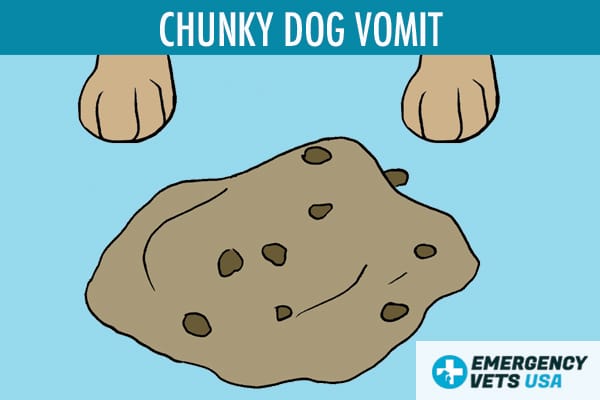
Chunky Dog vomit refers to the vomit that still contains partially digested food contents.
This vomit can range from an oatmeal consistency to having full kibbles that do not appear fully digested.
Chunky dog vomit can simply mean that your pup’s food has not had ample time to digest and that their upset stomach may be due to something they ate.
This can also mean that something is preventing them from passing their food content further throughout the GI tract.
2.) Liquid Vomit
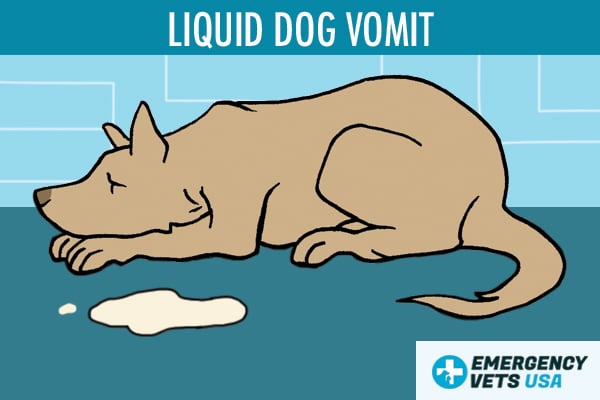
Liquid dog vomit is usually due to the fact that your dog does not have any food in their stomach at the time of their vomiting episode.
This is usually a cause for concern, as it points to the fact that your dog is still nauseous even though their stomach is empty.
Dog’s that vomit liquid or bile are usually experiencing other symptoms such as abdominal pain, drooling, lethargy, and other signs of nausea.
3.) Foreign Object Vomit
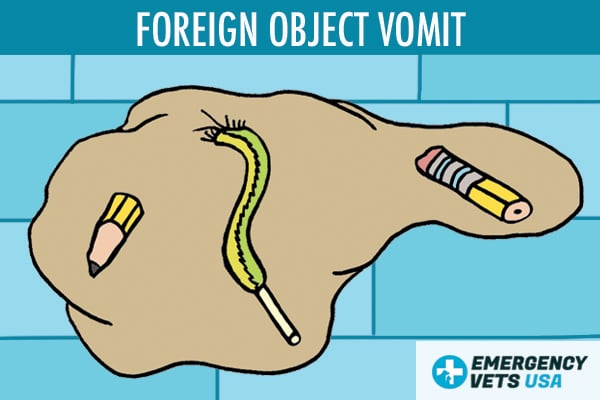
Sometimes our dogs can incriminate themselves by vomiting up a foreign object they ingested.
Dogs have been known to vomit pieces of toys they destroyed, socks, candy wrappers, plastic, and other objects they should not have had their paws on.
These foreign materials can sometimes hangout in our dog’s stomach for extended periods of time, even being vomited up days later in rare occurrences.
Dog Vomit Color Guide And What Each Color Means
Just as vomit texture can mean different things, so can dog vomit colors.
The color of your dog’s vomit can tell you a lot about their current illness, making it essential to understand these vomit colors when you see them.
In order to help you better understand your furry friend, let’s discuss different colors of vomit and what they mean.
Some can be life threatening, while others can be nothing to worry about.
Brown Vomit
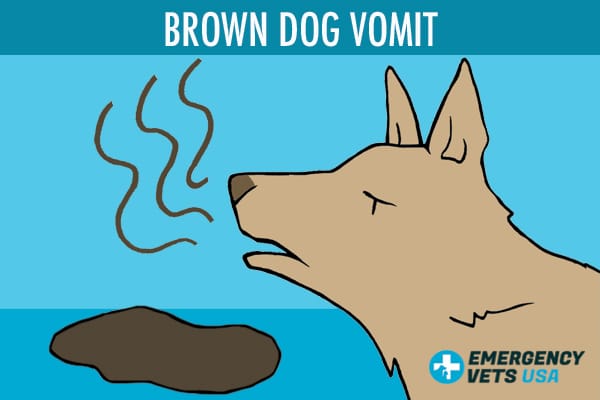
Brown dog vomit can point to a few different things. First, this may just be due to the color of your dog’s kibble.
If kibble is present in their vomit and it resembles that same color, this may just be the color in the kibble leaking throughout the vomit.
A more unsettling reason behind your dog’s dark brown vomit is due to eating feces.
The act of eating stool, coprophagia, is quite common in our furry friends.
You can often tell if your dog is eating stool by not only the color of their vomit, but also the foul smell of their breath.
Another possible cause of brown vomit in dogs is due to small traces of blood being present.
Blood can sometimes appear brown in the vomit, making it important to clean the vomit with light colored paper towels or rags when possible.
Sometimes the traces of blood can appear more vivid when using light colored clean up tools.
Green Vomit
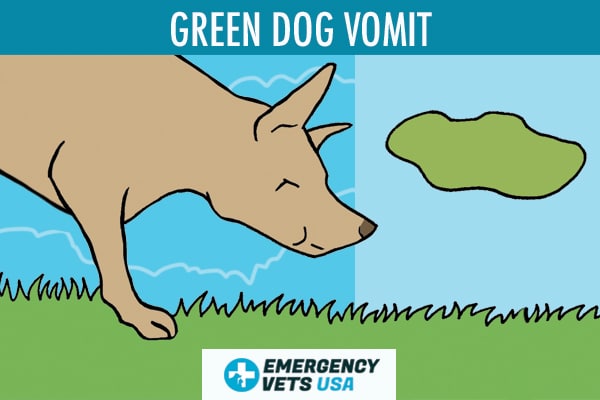
Green dog vomit can point to a few different causes.
First, your dog’s green vomit may be due to snacking on grass during their time outside.
Grass can certainly make your dog’s vomit appear to be bright green in come cases, but it will often contain pieces of plant material since grass is not easy to digest.
Green dog vomit can also indicate that there is bile present.
This can happen when your dog vomits on an empty stomach or when a dog suffers from reflux.
If your dog is vomiting without any food in their stomach, it’s best to have them seen by a vet as soon as possible.
This kind of vomit can indicate that it is not due to something they recently ate and is likely pointing to another cause.
Red Vomit
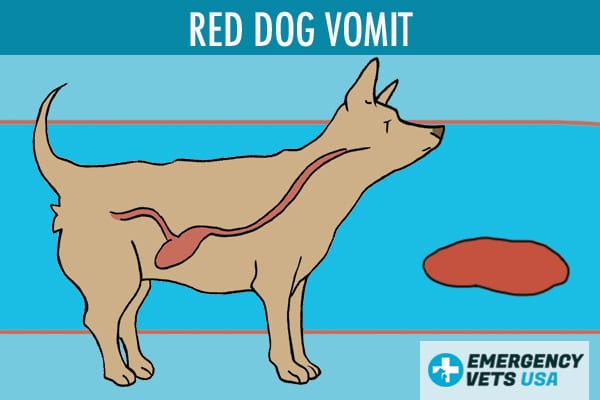
Red dog vomit rightfully startles many dog owners.
Since we often associate the color red with blood, it makes sense why dog owners call their vet immediately upon seeing their dog’s red vomit.
But what does it really mean?
First, it is important to consider the color of your dog’s food or treats before you assume it’s blood.
Many dog kibbles and treats contain red food dye, causing vomit to appear red if they just ingested either item.
If your dog has not eaten any red kibbles or treats recently then the red appearance does often point to blood being present.
Dogs can have bloody vomit due to stomach irritation, ulcers, HGE, and other serious gastrointestinal conditions that irritate the GI tract.
Blood in the vomit is a serious medical emergency that warrants you contacting your veterinarian as soon as possible.
Yellow Vomit
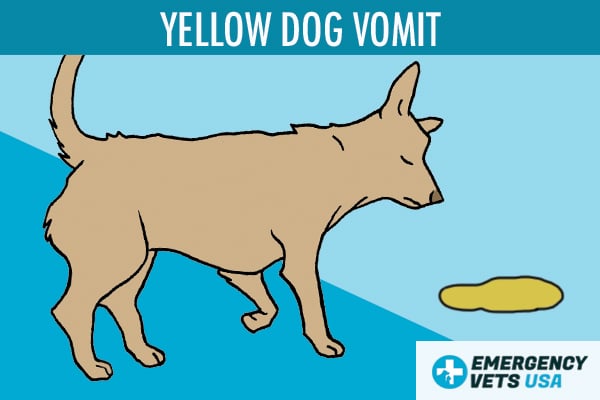
Yellow dog vomit is another sign of bile being present in the vomit.
If your dog threw up a yellow color, this can again point to your dog’s stomach being empty or the fact that they suffer from acid reflux.
Vomiting on an empty stomach will often indicate that their nausea is not due to something they recently ate.
Black Vomit

Black dog vomit is another daunting color that often frightens dog owners.
While black or dark colored vomit can be due to a dog eating soil or dirt, it can point to a serious problem in your pup.
Digested blood will often have a dark and granulated appearance, similar to the appearance of coffee grounds.
Any possibility of blood in the GI tract should be taken seriously, as it can point to a medical emergency.
If your dog is having black vomit or coffee ground like material in their vomit, it’s best to contact your vet as soon as possible.
White Vomit
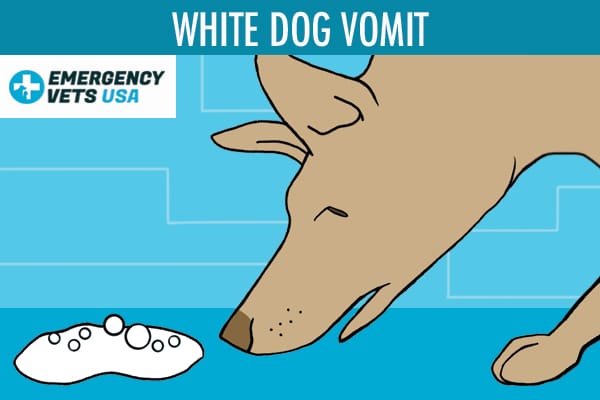
White dog vomit is usually foam in the vomit.
White foam in a dog’s vomit can be due to coming in contact with air as well as being sloshed around in the belly before it’s expelled.
Foam is more likely to be obvious in dogs that vomit on an empty stomach, since there are no chunky materials present.
Just as we have mentioned before, it’s best to contact your vet if your dog continues to vomit on an empty stomach.
Gray Vomit
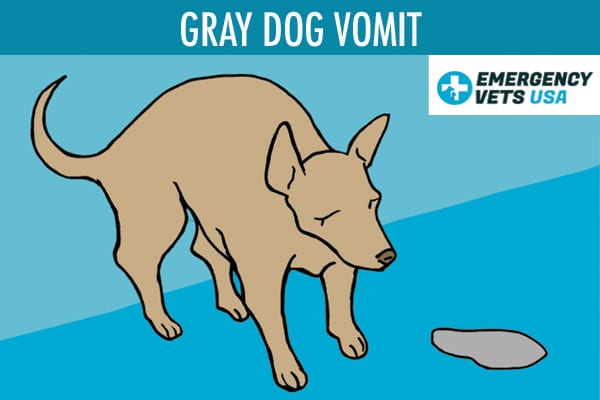
Gray liquid vomit is often a sign of prolonged gastrointestinal upset in our furry friends.
Liquid vomit in general often means there is not any food in a dog’s stomach, while gray vomit may indicate the presence of white foam or dilute bile.
Both of these suggestions mean a dog is avoiding their standard diet for whatever reason, and is likely unable to keep their food down when they do eat.
Anytime a dog experiences liquid vomit of any color, it’s best to contact your veterinarian for further advice.
Getting to the bottom of your dog’s nausea is essential for a full recovery, as many canine conditions can cause a dog to vomit or turn away from food, such as liver failure.
Your veterinarian will likely gather details of your dog’s medical history, as well as perform a few standard diagnostics.
Clear Liquid Vomit

If your dog is vomiting clear liquid it can mean that they are nauseous but have nothing in their stomach to throw up.
This can be a sign of acid reflux, bacterial infection, GI upset or an illness.

When Should You Contact A Veterinarian?
In short, you should always be a bit concerned when your dog is vomiting.
While dogs can certainly vomit once due to a minor stomach upset and be fine soon after, the cause of your dog’s vomiting is usually due to something that is making them feel ill.
Be sure to pay close attention to your pup immediately after they vomit and look out for other signs that point to them feeling unwell.
If your dog vomits more than once, it’s best to contact your vet for further advice.
Chronic vomiting can quickly dehydrate your dog, leading to great discomfort if left untreated, which can become an emergency that needs immediate treatment.
It’s important to get to the bottom of your dog’s symptoms quickly in order to get them back to feeling their best as soon as possible.
Final Thoughts On Dogs Vomit Color
We all care about our furry companions, making it so important to better understand them when they are feeling ill.
Be sure to review the color guide we listed above so that you can be prepared the next time your dog has a vomiting spell.

My name is Amber. I am a dedicated animal lover that turned my passion into my career. I am a Licensed Vet Tech with 12 years of experience in veterinary medicine, but I recently took my career online to help spread accurate information on animal care. With how vast the online world is, I have a strong desire to ensure that the reader always walks away with helpful pet advice. With the experience I’ve gained from my time in this field, I have been able to travel the world, offering my services to as many animal rescues as I can find. If I am not at my laptop, or back home visiting family, you can find me somewhere in the world, cuddling every furry friend that I can find! More About Us
